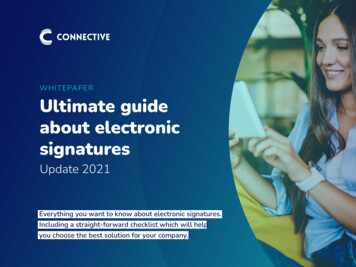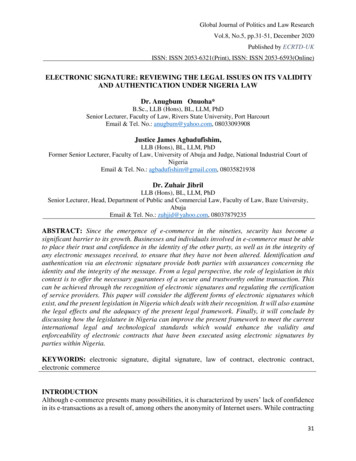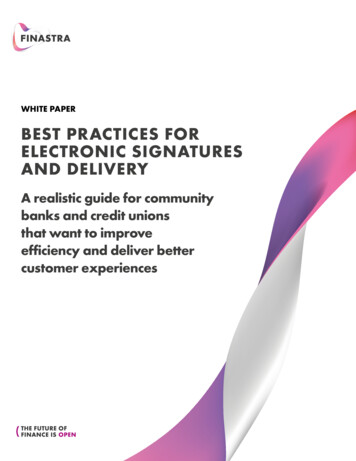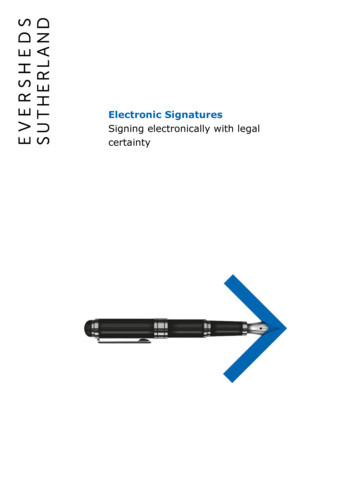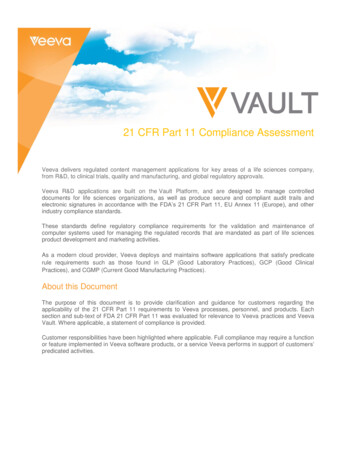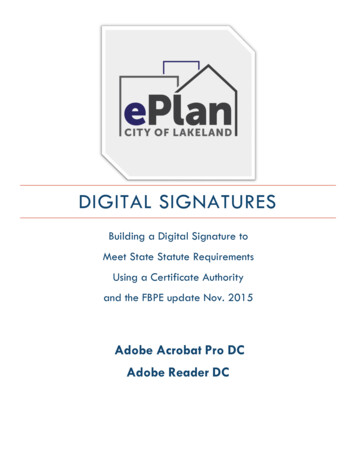
Transcription
WhitepaperImplementingElectronicSignaturesand DigitalSignatureswith DocuSign1
DocuSignImplementing Electronic Signatures and Digital Signatures with DocuSignElectronic and digital signatures around the worldElectronic signatures are broadly accepted throughout the world as an electronicreplacement to handwritten signatures. Most laws define an electronic signatureas electronic data that’s logically associated with a document and used by thesigner to indicate their agreement. For most use cases, customers and locations,a ‘simple' electronic signature is sufficient. However, some transactions in certaincountries, in heavily regulated industries or with governmental entities mayrequire or prefer digital signatures, a type of electronic signature that offers aheightened level of identity assurance and security.Digital signatures are based on a technology standard called Public KeyInfrastructure (PKI), a widely accepted format that provides the highest levelsof security and broad acceptance. PKI is a set of requirements involving the useof certificates and cryptographic keys that allow (among other things) thecreation of digital signatures.With PKI, each digital signature transaction involves a pair of keys—oneprivate, one public. The private key isn’t shared and is used only by the signerto electronically sign documents. The public key is openly available and used bythose who need to validate the signer’s electronic signature.To protect the integrity of the signature, PKI requires that the keys be created,conducted and saved in a secure manner and often requires the services of areliable Certificate Authority (CA). DocuSign is a CA in some key jurisdictions,including the European Union.Around the world, there are international standards that govern the use ofelectronic and digital signatures as well as the methods used to authenticatea signer, like eIDAS. To learn the facts about current e-signature laws, visit theDocuSign eSignature Legality Guide.2
DocuSignImplementing Electronic Signatures and Digital Signatures with DocuSignThe eIDAS regulationIn the European Union, all electronic signatures are governed by regulation 2014/910, known as eIDAS.The eIDAS regulation is applicable throughout the European Union and recognizes three types ofelectronic signatures: electronic signatures, advanced electronic signatures (AES) and qualifiedelectronic signatures (QES). Customers can use DocuSign eSignature solutions to deliver all three.These three electronic signatures offer increasing levels of legal protection, and as the level of assuranceincreases, the implementation requirements become more stringent. eIDAS doesn’t prescribe whichsignature should be used for which scenario. As a consequence, the level of signature that organizationsselect is based on established and local industry usage, specific laws (e.g., German employment law)and the organization’s risk tolerance.– Electronic signature is a signature in electronic form, appropriate for most use cases and simpleto implement. Identity verification or authentication of signatories can be added, but isn’t required.– Advanced electronic signature (AES) adds an identity verification requirement. Signatures must beuniquely linked to, and capable of identifying, the signer. In the event of a dispute involving an AES,the burden of proving the validity of the signature lies with the signer.– Qualified electronic signature (QES) requires face-to-face identity verification. The face-to-faceidentification can be live, in-person or via an audio/video connection. A QES is unique in that it’sconsidered legally equivalent to a handwritten signature under eIDAS. A QES also shifts the burdenof proof. The burden of proving the invalidity of the signature lies with the challenging party. Finally, thelaw on QES requires that every member state accept the validity of a QES even if it was executed inanother member state of the EU.While QES has a special legal status in the EU (more on that in the section below on QES), all threeelectronic signature levels ensure that the legal effect, and the admissibility of the electronic signaturecan’t be refused just because the signature is in electronic form (eIDAS, Article 25-1).Therefore, from a legal point of view, the differences between an electronic signature, AES and QESrelate mainly to the ID verification process and where the burden of proof lies, as noted above. When adispute does arise, the Certificate of Completion that DocuSign generates for each signing experienceserves as an audit trail and proof of the transaction regardless of the type of signature used.In the sections that follow, we explore in more detail the three electronic signatures, as defined by eIDASregulation, as well as how DocuSign supports each of them.There's a signer's assurance spectrum for the three levels of signatures3
DocuSignImplementing Electronic Signatures and Digital Signatures with DocuSignElectronic signaturesAn “electronic signature” is defined (eIDAS Art 3-10) very broadly as "data in electronic form, which areattached or logically associated with other data in electronic form and which the signatory uses to sign."An electronic signature is appropriate for most use cases, such as internal documents, business-toconsumer transactions or agreements with existing partners or signers. It’s simple and has fewrequirements associated with it, making it an efficient form of e-signature for most agreements.Advanced electronic signaturesAn AES is defined (eIDAS Art 3-11 and 26) more precisely than an electronic signature.In particular, an AES must:– Identify the signatory– Be uniquely linked to the signatory– Be created using electronic signature creation data that the signatory can, with a high confidencelevel, use under their sole controlDocuSign offers two AES options, depending on whether the identification of the signer is carried outby DocuSign or someone delegated by DocuSign (e.g., a DocuSign customer).1/ AES with identity verification performed by DocuSign ID VerificationDocuSign supports AES by adding DocuSign ID Verification to DocuSign eSignature. With this solution,DocuSign identifies the signer by presenting an official proof of identity online.How it works:– When signers receive the document, they’re asked to provide proof of identity, with the optionto submit an electronic ID or a photo of their passport, identity card or driver’s license using theircomputer or mobile device– DocuSign then:· Checks the authenticity of the identity document, extracts the name and compares it to the signername specified by the sender· Generates a digital certificate validating the signer’s identity· Allows the signer to use the digital certificate to sign the document and creates a Certificate ofCompletion associated with the transaction– Senders can also choose to retain elements of identity data (including a copy of the ID document) andexport that data to their own systems of record for audit or compliance purposes.4
DocuSignImplementing Electronic Signatures and Digital Signatures with DocuSign2/ AES with identity verification delegated to a third partyAs an accredited Trust Services Provider (TSP) in the EU, DocuSign also supports AES by combiningDocuSign eSignature with delegation of the AES signer identity verification to the DocuSign customerrequesting the signature.With this option, DocuSign customers are responsible for identifying the signer.How it works:– Before creating the envelope, the DocuSign customer verifies the identity of the signer and collectstheir phone number, which is used to send a one-time password via text message– The sender prepares the document to be signed by selecting the AES option from their sendingexperience screen– The sender is prompted to add the signer’s phone number, upon which DocuSign sends the signer aone-time password prompt and the document to sign (the sender can also send an access code tothe signer using a source outside of DocuSign)– The signer opens the document on their device and is prompted to sign– Once the signer adopts their signature, a prompt asks them to enter their one-time password oraccess code– The signer’s AES signature is confirmed and DocuSign generates a Certificate of Completion– The certificate, which is associated with the signature, contains proof of the authentication processused to confirm the identity, the signer’s IP address and email and the timestamp of different steps inthe transaction– DocuSign also stores, as required by law, proof of the identity verification5
DocuSignImplementing Electronic Signatures and Digital Signatures with DocuSignQualified electronic signaturesUnder EU law, a QES is legally equivalent to a handwritten signature (Article 25.2). In certain EU memberstates, a QES is mandated by law for specific use cases. Additionally, organizations may choose it forcertain agreements. A QES offers non-repudiation and shifts the burden of proof in the event of adispute. In this instance, the burden of proving the invalidity of the signature lies with the challengingparty (i.e., the party that’s contesting the validity of the QES).A QES is a convenient option in cross-border transactions within the EU, because a QES issued in oneEU member state must be recognized as such in another. On the other hand, a QES requires the signer’sidentity to be verified face-to-face or through an equivalent process performed by a certified agent.In the past, this presented a barrier to adoption. However, the emergence of artificial intelligence andonline identification services is making this face-to-face requirement more and more affordable, enablingsigners to identify themselves using their smartphone camera.DocuSign offers several options for obtaining qualified electronic signatures.1/ DocuSign ID Check Remote for QESDocuSign offers remote video identity verification conducted by certified agents through our preferredpartnership with IDNow. Integrated into DocuSign eSignature, the video face-to-face identificationhappens the first time the signer uses the IDNow service, after which, the signer may create anaccount that can be reused for future QES signings for two years without the need for additional videoidentification.How it works:– DocuSign presents the document to the signatory for signature and, if the person is using ID CheckRemote for the first time, starts a video session that connects them to an agent who asks them fortheir mobile phone number and proof of identity– The agent· Verifies the identity of the signer by comparing the name on the document with the name specifiedby the sender· Confirms that the photo shown on the document corresponds to the person present in the video chat· Checks the authenticity of the ID document by examining the security features visible in white light– DocuSign then:· Obtains consent from the signer to sign through two-factor authentication (access to their personalaccount and a one-time code sent by SMS to the their mobile phone)· Applies the digital signature to the document· Generates a qualified electronic certificate associated with the signatory and the transaction· Executes the qualified electronic signature on behalf of the signatory in accordance with article 30and Annex II-3 of the eIDAS regulation· Generates the Certificate of Completion associated with the signature6
DocuSignImplementing Electronic Signatures and Digital Signatures with DocuSign2/ DocuSign ID Check In-Person for QESThis option is well suited to cases where the sender (usually a DocuSign customer) has already met thesigner in a face-to-face meeting before the signing action or is meeting the signatory face-to-face at thetime of the signing action, as in the case of an in-person sale.With this option, DocuSign delegates the identity verification to the DocuSign customer. As part of thisprocess, the sender also captures the phone number of the recipient, which is used to confirm signingintention through a one-time access code sent via SMS.How it works:– DocuSign presents the document to the signer for signature– The signatory applies the representation of his signature on the agreement– DocuSign asks the signer to capture a photo of their proof of identity (passport, identity card or driverlicense) using their smartphone’s camera– DocuSign then:· Checks the authenticity of the identity document, extracts the name and compares it to thesignatory’s name specified by sender· Obtains their consent to sign by sending an access code to the mobile phone that was provided bythe sender when creating the envelope· Generates a qualified electronic certificate associated with the signatory and the transaction· Executes the qualified electronic signature on behalf of the signatory on a qualified signaturecreation device operated remotely· Generates the Certificate of Completion associated with the signature3/ QES using an existing qualified certificateBeyond its own product offerings, DocuSign accepts and supports all QES stored on physical electronicIDs (eIDs), smart cards and USB tokens issued by qualified providers on the EU Trust Services List.1The EU Trust List tracks all Qualified Trust Service Providers (QTSP) across the European Union, and theDocuSign eSignature interface allows the signer to produce a digital signature using a device witha qualified certificate.This option is designed for businesses whose employees are issued a smart card or USB token with aqualified certificate or whose customers carry a device that contains a qualified certificate.Several EU member states provide their citizens with digital certificates on a smart card or eIDs, such asGermany, Belgium, Estonia and Spain, so they can be used to sign agreements with an eIDAS-compliantdigital signature.1The Member States of the European Union and European Economic Area publish trusted lists of qualified trust service providers in accordance withthe eIDAS Regulation. The European Commission publishes a list of these trusted lists, the List of Trusted Lists (LOTL). The European Commission,through the CEF Digital program, provides this tool for anyone to browse the national trusted lists and the LOTL.7
DocuSignImplementing Electronic Signatures and Digital Signatures with DocuSign4/ Digital signatures with certificates issued by trust service providersIn addition to the options above, DocuSign generates digital signatures using digital certificatesissued by TSPs. Since these TSPs are accredited by national certification bodies around the world,the signatures obtained by using their digital certificates are legally binding and comply with the localregulations and standards for what an advanced or a qualified signature represents.DocuSign supports signing with digital certificates in two ways:– In the European Union, DocuSign issues eIDAS-compliant digital certificates: DocuSign is a QTSPon the EU Trust List and is accredited by the French National Authority. Thanks to the EuropeanUnion’s Internal Market Principle, digital certificates issued by DocuSign France are valid, legally bindingand accepted by every one of the 27 EU Member States.– Integrated with local TSPs around the world: By supporting signing with certificates issued by TSPsaccredited by local authorities in dozens of countries, DocuSign offers the ability to generate digitalsignatures that are legally binding, and compliant with local regulations. This local, digital signaturecompliance allows DocuSign customers to sign agreements around the world using a trusted, singlesolution.ConclusionElectronic signatures are a fast and simple way of signing agreements and can be used in nearly allthe same instances as handwritten signatures. Digital signatures, a type of electronic signature, offer aheightened level of identity assurance, like electronic “fingerprints.” They securely associate a signer witha document in a recorded transaction in the form of a coded message.DocuSign supports electronic and digital signatures around the world, including the three signaturelevels defined by the European Union through the eIDAS regulation: electronic signatures, advancedelectronic signatures and qualified electronic signatures. This allows companies of all sizes to completeapprovals, agreements and transactions faster while staying compliant with eIDAS.This support also includes cloud-based digital certificates that contain public keys for the digitalsignatures and specify the identities associated with the keys. These certificates are used to confirmthat the signature belongs to the person who signed the document. Along with the digital certificatethat all Certificate Authorities provide, DocuSign also generates a Certificate of Completion that servesas an audit trail and proof of the transaction for all signing parties.Altogether, DocuSign provides a smooth signing experience for organizations who must comply witheIDAS and other similar regulations around the world. For more information on e-signature requirementsaround the world, see the eSignature Legality Guide and consult your organization’s legal counsel.About DocuSignDocuSign helps organizations connect and automate how they prepare, sign, act on and manage agreements.As part of the DocuSign Agreement Cloud, DocuSign offers eSignature, the world’s #1 way to sign electronicallyon practically any device, from almost anywhere, at any time. Today, over a million customers and more thana billion users in over 180 countries use the DocuSign Agreement Cloud to accelerate the process of doingbusiness and simplify people’s lives.DocuSign, Inc.221 Main Street, Suite 1550San Francisco, CA 94105For more informationsales@docusign.com 1-877-720-2040docusign.com8
An electronic signature is appropriate for most use cases, such as internal documents, business-to- consumer transactions or agreements with existing partners or signers. It's simple and has few requirements associated with it, making it an efficient form of e-signature for most agreements.
